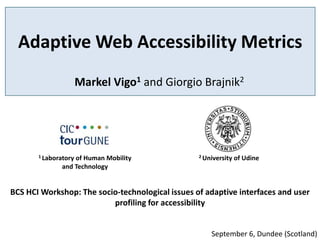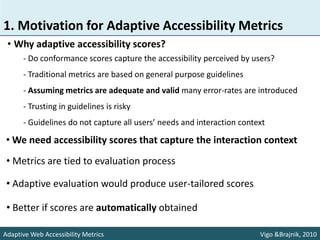Adaptive web accessibility metrics
- 1. Adaptive Web Accessibility Metrics Markel Vigo1 and Giorgio Brajnik2 1 Laboratory of Human Mobility 2 University of Udine and Technology BCS HCI Workshop: The socioŌĆÉtechnological issues of adaptive interfaces and user profiling for accessibility September 6, Dundee (Scotland)
- 2. 1. Motivation for Adaptive Accessibility Metrics ŌĆó WeŌĆÖd like to know the answer to this question: ŌĆ£To what extent is accessible a web pageŌĆ” - for a determined user with their own abilities - using a determined Assistive Technology and user agent - operating a specific device - and carrying out a determined taskŌĆØ ŌĆó ŌĆ”equals to measuring accessibility in use or contextual accessibility ŌĆó There are some scenarios that could benefit - As a way to measure interface adaptations - Adaptive hypermedia techniques - Accessibility observatories and QA ŌĆó Traditional web accessibility metrics aim at measuring accessibility wrt to conformance Adaptive Web Accessibility Metrics Vigo &Brajnik, 2010
- 3. 1. Motivation for Adaptive Accessibility Metrics ŌĆó Why adaptive accessibility scores? - Do conformance scores capture the accessibility perceived by users? - Traditional metrics are based on general purpose guidelines - Assuming metrics are adequate and valid many error-rates are introduced - Trusting in guidelines is risky - Guidelines do not capture all usersŌĆÖ needs and interaction context ŌĆó We need accessibility scores that capture the interaction context ŌĆó Metrics are tied to evaluation process ŌĆó Adaptive evaluation would produce user-tailored scores ŌĆó Better if scores are automatically obtained Adaptive Web Accessibility Metrics Vigo &Brajnik, 2010
- 4. 2. Challenges and Engineering solutions Challenge 1: how to capture interaction context data (non intrusively) ŌĆó Select only those guidelines that impact on a determined user group ŌĆó Not enough ŌĆó Context is key for adaptive evaluations ŌĆóDetecting installed Assistive Technology and user agents is a step forward ŌĆó Evaluation tools need a user profile as an input Adaptive Web Accessibility Metrics Vigo &Brajnik, 2010
- 5. 2. Challenges and Engineering solutions Challenge 2: quantify severity of violated accessibility barriers ŌĆó Weight barriers for a specific user context ŌĆó Application scenarios require real-time scores ŌĆó How to quantify barriers automatically? ŌĆó Make use of infrastructures such as Accessibility Commons ŌĆó Accessibility metadata stored beforehand ŌĆó Triples: <accessibility problem, context, severity> Adaptive Web Accessibility Metrics Vigo &Brajnik, 2010
- 6. 2. Challenges and Engineering solutions Challenge 3: reasoning over guidelines ŌĆó Not to tie the metric to a determined guideline set ŌĆó No matter which guideline set is used the metric should adapt to it ŌĆó Guidelines have to be specified in a common language so that evaluation tools can understand them ’āĀinteroperability ŌĆó Metrics require parameters such as number of applied guidelines, severities, etc ’āĀinference ŌĆó Interoperability + inference = ontologies? Adaptive Web Accessibility Metrics Vigo &Brajnik, 2010
- 7. Adaptive Web Accessibility Metrics Markel Vigo1 and Giorgio Brajnik2 1 Laboratory of Human Mobility 2 University of Udine and Technology BCS HCI Workshop: The socioŌĆÉtechnological issues of adaptive interfaces and user profiling for accessibility September 6, Dundee (Scotland)
Editor's Notes
- #3: Accessibility in use: the property of a site to support the same level of effectiveness for people with disabilities as it does for non-disabled peopleUser context and would consist of the user profileCheck the effectiveness of interface adaptationsprecisely in numeric/qualitative terms. It is useful to meet laws that enforce inclusive design
- #4: BUT why we need adaptive metrics?There is a plethora of research stating that guidelines conformance does not necessarily ensure accessibilitySome scenarios require real time scoresBefore we obtain user-tailored scores there are some challenges that should be faced by both adaptive evaluation/measurement
- #5: To do so we need to address the following challenges Intuitive solution and initial approachwe need a dynamic selection of guidelines that do applyencapsulating in a CC/PP profile
- #6: Some proposed methods can weight violations applying human intervention
- #7: As a conclusion,Do we need an adaptive evaluation method and then apply common metrics?or we need traditional methods and apply adaptive accessibility metrics?Do we need both?What do you think?







